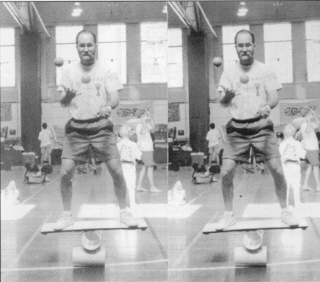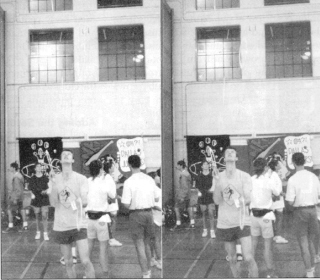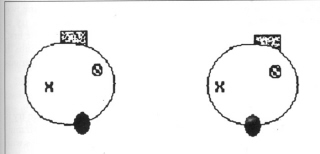 |
 |
 |
 |
Page 29 Winter 1992 - 93
|
Montreal
In Stereo By Duane Starcher
To
see any scene in three dimensions, it is necessary to view one image
with the left eye and a slightly different one with the right eye.
This is the way we normally see the world, but we are not used to
looking at photographs this way. Unless one is using an optical viewer
like an old stereoscope, it has to be learned. Some people find this
easier than others, but nearly everyone with two good eyes is able to
accomplish it with a bit of practice.
There
are two possible ways to view stereo photographs without a viewer. One
is referred to as "free viewing," the other as "cross
viewing." In free viewing, the left eye looks at the left image
of the pair and the right eye at the right image. The eye muscles are
relaxed as if staring off into the distance. This manner of viewing
does not tire the eyes and is the preferred method. Stereo pairs
printed in magazines usually have a small separation (-6Omm), so free
viewing is easy. Antique stereo cards often have larger separations
(+65mm) and most people can free view them without practice.
In cross viewing, the images are reversed and the left eye must look at the right image, the right eye at the left image. For most people cross viewing is easier to learn, since nearly everyone can cross his or her eyes. However, crossing the eyes puts a strain on the muscles and can't be maintained for long without irritation. In cross viewing, the final image also appears somewhat smaller and less natural than in free viewing. Cross viewing is normally used only for presenting images that are too large to be seen in free viewing.
Free
viewing involves relaxing the eyes, as if you were looking at a
distant object on the horizon. The left and right lines of sight
approach the parallel while focusing on the images in front of each
eye. This is the trick. All your life you have focused far away while
looking into the distance. Now you have to learn to look into the
distance, but focus on a photograph a foot from your nose.
What
will you see? When you are successful, you will see one image
overlapping another, with two outside images that you will ignore. The
center image will be the combination of the image on the left and the
image on the right. This combination will trigger your brain to
interpret it as a scene with depth. The simpler the image you 'are
viewing, the easier it will be for your brain to sort it all out. So,
choose simple images to learn free viewing and you will have better
success than starting off with complex photographs.
Fold the page so you can see over the top of the image below. Hold the page steady in front of your eyes, then look slightly over it into the distance. (Go outside or sit in front of a window so you have something far off to see, rather than a nearby wall.) Feel your eye muscles. Your aim is to look at the page, yet relax your eye muscles as if they were looking into the distance. Don't worry if the image is not clearly in focus. Just get the pair to merge and stay merged. Once you can do this pair, try the photos. They're much the same, but the spacing is wider. |
 |
 |
 |
 |